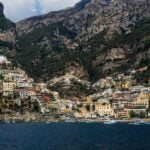Unveiling Naples: Enigmatic History, Lively Streets & Exquisite Cuisine—a title that encapsulates the essence of this captivating Italian metropolis. With a rich history that stretches back for centuries, Naples is a city steeped in enigmatic stories and cultural nuances. Nestled in the shadows of the formidable Mount Vesuvius, it has witnessed countless chapters of triumph and tragedy. But beyond its tumultuous past, Naples is also known for its lively streets, filled with vibrant characters and bustling markets that give life to the city. And of course, no discussion of Naples would be complete without mentioning its exquisite cuisine—where the art of pizza-making was born. Join me as we embark on a journey to unravel the three intriguing facets that define Naples, offering unique insights into this unparalleled destination.

What are three interesting facts about Naples?
Naples, a city with a storied past, pulsating streets, and tantalizing cuisine, unveils its secrets through the following intriguing facts:
1. Naples: A Greek Connection
Step back in time and uncover Naples’ rich historical heritage. Did you know that the name “Naples” originates from the Greek word Neapolis, which translates to “New City”? This ancient Greek influence adds an alluring layer to the city’s identity. Naples, with its deeply rooted ties to Greek civilization, becomes a captivating gateway where the old and the new harmoniously coexist.
As you wander through the vibrant streets, you’ll find remnants of Naples’ Greek past, acting as a reminder of the city’s enduring cultural allure. The splendid architecture, authentic cuisine, and warm-hearted locals are testaments to the legacy left behind by the ancient Greeks. The Greek connection continues to infuse Naples with an enigmatic charm that beckons travelers from near and far.
“Transport yourself to a bygone era as you explore the captivating nooks and crannies of Naples, a city shaped by its Greek roots.”
2. Naples: Where History and Modernity Converge
While Naples has evolved into a bustling metropolis, it proudly wears its historical treasures on its sleeve. This Italian gem is not only the third largest city in Italy but also boasts one of the busiest ports in all of Europe. This bustling harbor has long been a gateway for cultural exchange and trade, making Naples a melting pot of diverse influences from across the globe.
Step into the time capsule of Naples’ past when you visit the ancient catacombs dating back to the 3rd century. These eerie underground tunnels serve as a haunting reminder of the city’s history, where early Christians sought refuge and laid their loved ones to rest. Marvel at the impressive 13th-century cathedral, a symbol of religious devotion and intricate architectural craftsmanship.
“Naples pulsates with a vibrant energy, harmoniously blending its rich history with the fast-paced modernity of a bustling metropolis.”
3. Naples: A Culinary Paradise
Prepare to tantalize your taste buds in the birthplace of the iconic pizza. Naples prides itself on being the home of this beloved Italian dish. Legend has it that Queen Margherita herself fell in love with the famous Margherita Pizza during a visit to Naples, earning it its name. Crispy yet chewy Neapolitan pizza crust, freshly made tomato sauce, and melt-in-your-mouth mozzarella cheese blend harmoniously to create a flavor symphony.
But Naples offers more than just pizza. Venture into the city’s alleyways and discover a culinary wonderland. Sample the succulent, freshly caught seafood dishes that pay homage to Naples’ coastal location. Indulge in street food delights like arancini and zeppole, or savor the creamy delight of traditional Neapolitan gelato. Naples truly spoils the taste buds of its visitors, leaving behind a trail of delicious memories.
“Embark on a mouthwatering journey through Naples, savoring its signature pizza and exploring a vibrant gastronomic world waiting to be discovered.”
In Naples, ancient history intertwines with modern vibrancy, captivating all who venture into its captivating realm. From its Greek origins to its bustling port and mouthwatering cuisine, Naples boasts a captivating allure that has stood the test of time. So dive into its enigmatic history, soak in the lively streets, and indulge in its exquisite cuisine, and let Naples enchant you like no other city can.
Table: Famous Dishes in Naples
| Dish | Description |
|---|---|
| Margherita Pizza | The iconic Neapolitan pizza, named after Queen Margherita, features a crispy yet chewy crust topped with tomato sauce, mozzarella cheese, and fresh basil. |
| Seafood Spaghetti (“Spaghetti alle Vongole”) | A delectable seafood pasta dish, “Spaghetti alle Vongole” combines flavorful clams, garlic, parsley, olive oil, and chili flakes, all tossed with perfectly cooked spaghetti. |
| Neapolitan Pastiera | This traditional Easter cake is a delightful blend of ricotta cheese, wheat berries, candied fruit, aromatic spices, and a touch of citrus, making it a sweet and fragrant treat. |
Naples, Italy, is a city filled with rich history, stunning architecture, and a vibrant local culture. But did you know that Naples is also home to a plethora of fun facts? From being the birthplace of pizza to having the world’s oldest opera house, this city is full of intriguing tidbits. If you’re ready to dive deeper into the fun facts about Naples Italy, click here to uncover even more fascinating information at ../fun-facts-about-naples-italy!
50 Fascinating Facts about Naples, Italy
[youtube v=”GTZNkVA9ZqE”]
History and Culture
Naples, also known as Napoli, is a city in Italy with a rich and fascinating history. Here are 50 facts about Naples that highlight its unique culture, heritage, and contributions to the world.
Greek Origins: Naples was first settled by the Greeks, and the name of the city, Neapolis, actually means “New City” in ancient Greek.
Third Largest City: Naples is the third largest city in Italy, after Rome and Milan, making it a vibrant and bustling metropolis.
Ancient Catacombs: The city is home to two ancient catacombs, the Catacombs of San Gennaro and San Gaudiozo, which date back to the second century.
Birthplace of Pizza: Naples is famous for being the birthplace of pizza. The iconic Margherita Pizza was named in Naples after Queen Margherita.
Oldest Pizzeria: The first-ever pizzeria in the world, Antica Pizzeria Port’Alba, was founded in Naples in 1830 and is still open to this day.
City of Castles: Naples is known as the “City of the Seven Castles.” Some of the most notable ones are Castel dell’Ovo, Castel Nuovo, and Castel Sant’Elmo.
Densely Populated: Naples is the most densely populated city in Italy, with over one million people living in the city center alone.
Funiculars and Transportation: The central funicular in Naples is one of the most used funiculars in the world, carrying approximately 10 million passengers every year.
UNESCO World Heritage Site: The historical center of Naples, with its wealth of historical buildings and monuments, is listed as a UNESCO World Heritage Site since 1995.
Volcanic Threat: Naples is constantly under threat from Mount Vesuvius, one of the most dangerous volcanoes in the world. The nearby Campi Flegrei is also an underwater volcano in the Gulf of Pozzuoli.
Food and Cuisine
Culinary Delights: Naples is renowned for its culinary scene. It offers a diverse range of delicious dishes, including fresh seafood, traditional Neapolitan pizza, and mouthwatering gelato.
Rivers and Construction: The city used to have rivers, but over time they have been covered by construction, and today there are no rivers in Naples.
Pizza Festival: Naples hosts a pizza festival called Pizza Fest, where visitors can enjoy pizza contests, entertainment, cooking classes, and live events.
Neapolitan Mafia: Naples is also known for its association with the Camorra, one of the oldest criminal organizations in Italy, founded in the 17th century.
Resistance against Nazis: During World War II, Naples was the first Italian city to rise up against the Nazi military occupation. The locals successfully pushed the Germans out in what became known as the “Four Days of Naples.”
Landmarks and Tourist Attractions
SSC Napoli: The city is home to the famous football team SSC Napoli, which has won the Italian championship twice. They play their home matches at Stadio Diego Maradona.
Architectural Styles: Naples showcases a blend of architectural styles, including medieval, Renaissance, and Baroque styles due to its rich history.
Archaeological Museum: The National Archaeological Museum of Naples houses one of the world’s most extensive collections of Roman artifacts, showcasing the city’s ancient past.
Religiosity and Churches: Catholicism plays a significant role in Neapolitan culture, with hundreds of churches spread throughout the city. The Cathedral of Naples is the main place of worship.
Patron Saint: The patron saint of Naples is Saint Januarius, and the city attracts thousands of pilgrims who gather to witness the miracle of his dried blood turning to liquid.
Natural and Geographical Wonders
Subterranean Naples: Underneath Naples, there is a series of caves and structures that have been created by centuries of mining, offering visitors a fascinating glimpse into the city’s underground.
Green Spaces: Naples boasts several parks and green spaces. The largest one, Bosco di Capodimonte, also houses the Museo e Real Bosco di Capodimonte.
Islands of Naples: The bay of Naples is dotted with three main islands – Procida, Capri, and Ischia, each offering unique natural beauty and attractions that can be reached by ferry from Naples.
Education and Intellectual Contributions
Historic University: Naples is home to Università Federico II, believed to be the oldest state university in the world, founded in 1224.
State-of-the-Art Observatory: The city hosts the state-of-the-art astronomical observatory of Capodimonte, established in 1812, renowned for its significant contributions to astronomy.
Sophia Loren: The famous actress Sophia Loren, widely regarded as one of the greatest stars of classical Hollywood and Italian cinema, was born in Naples and holds honorary citizenship.
Economy and Tourism
Economic Importance: Naples ranks as Italy’s fourth largest economy after Milan, Rome, and Turin. It also holds the position of the world’s 103rd largest urban economy.
Top Tourist Destination: Naples is a major national and international tourist destination, attracting visitors from all over the world. Its rich history, vibrant culture, and stunning landmarks make it a must-see city.
Transportation Hub: Naples is well-connected through various transportation networks. The A1 motorway, also known as the Outer Strada, is the longest motorway in Italy, linking Naples with Milan.
International Airport: The Naples International Airport (Aeroporto di Napoli-Capodichino) is the largest airport in southern Italy, serving as a gateway for both domestic and international travelers.
Metro Artistry: The Naples underground metro, La Metropolitana di Napoli, is not only a practical means of transportation but also known for its decorative architecture and public art.
Arts and Entertainment
Neoclassical Influence: Naples experienced a period of neoclassicalism in the 18th century, inspired by the discovery of remarkably intact Roman ruins in Herculaneum and Pompeii.
Theatrical Legacy: Naples boasts some of the oldest theaters in Europe. One notable example is the Teatro di San Carlo, which dates back to the 18th century.
Colorful Cinema: Naples has made significant contributions to Italian cinema. One of the first Italian color films, “Tartarin of Tarascon,” starred the iconic actor Antonio de Curtis, known as “Totò.”
Mediterranean Cuisine: The nutritional value of Neapolitan cuisine was scientifically recognized in the 1950s. It is considered one of the finest examples of the healthy Mediterranean diet.
Language and Literature
Preservation of Neapolitan: The Neapolitan language/dialect is protected and enhanced by regional law in Naples. It is considered an essential part of the city’s cultural heritage.
Literary Capital: Naples has played a significant role in Italian literature. In the 15th century, King Alfonso V declared that Neapolitan should be used instead of Latin in official documents.
Puppetry Tradition: Naples has a long-standing tradition of puppetry, with the character Pulcinella symbolizing the common man who uses humor and wit to face life’s challenges.
Musical Heritage: Naples has been a hub for Western European music for over four centuries. It has given birth to its own unique music styles, such as the Canzone Napoletana and opera buffa.
Instruments: Naples is credited with the creation of several musical instruments, including the mandolin, tammorra, and pizzica.
Miscellaneous
Awards and Honors: Naples, with its unique attractions and offerings, has received numerous awards for its cultural, historical, and culinary contributions.
Astronomy Contributions: The city’s important contributions to astronomy are reflected in the naming of minor planets, including “2046 Napoli” and “685 Neapolis.”
Birthplace of Espresso: The traditional Neapolitan coffee pot was the inspiration for the development of the espresso machine. Naples has a deep-rooted coffee culture.
Film Production: Besides being a city of notable actors and actresses, Naples has also facilitated the production of numerous films and TV series, showcasing its charm on the big screen.
Medieval Origins: Naples has a medieval origin, and its historical center is a treasure trove of medieval architecture, including churches, castles, and narrow streets.
Folk Theater: One of Italy’s most renowned theater styles, the “Sceneggiata Napoletana,” is a prominent genre of modern folk theater that originated in Naples.
Roman Contributions: Naples has UNESCO-listed archaeological sites, such as Pompeii and Herculaneum, that provide invaluable insights into ancient Roman civilization.
Artistic Influence: Many famous artists, including Caravaggio and Giuseppe Sanmartino, have left their mark on Naples, enriching it with their artistic creations.
Colorful Gelato: Naples is famous for its gelato, which comes in a wide array of colors and flavors, such as lemon, pistachio, and hazelnut.
Vibrant Festivals: Naples hosts numerous festivals throughout the year, celebrating everything from local saints to music, food, and art, creating a lively atmosphere.
As you can see, Naples offers a wealth of history, culture, and culinary delights. Whether you are interested in exploring ancient Roman ruins, indulging in authentic Neapolitan pizza, or immersing yourself in the city’s vibrant atmosphere, Naples has something for everyone. Plan your visit to this enchanting city and discover its wonders for yourself!
“Naples: A city that blends rich history, vibrant culture, and mouthwatering cuisine. Explore Roman ruins, savor authentic Neapolitan pizza, and immerse yourself in the city’s lively atmosphere. Discover the wonders of Naples!”

FAQ
Q: What are three interesting facts about Naples?
A:
1. Naples, derived from the Greek word Neapolis, means “New City.” This name reflects its ancient origins and continuous development throughout history.
2. Known as the third largest city in Italy and boasting one of the busiest ports in Europe, Naples is a bustling hub of activity and commerce.
3. Naples holds fascinating historical treasures, such as catacombs from the 3rd century and a magnificent cathedral dating back to the 13th century.
Q: What is the significance of Naples in relation to pizza?
A:
Pizza, one of the most beloved dishes worldwide, was actually invented in Naples. This birthplace of pizza offers a special connection to this culinary masterpiece. In fact, the famous Margherita Pizza was named after Queen Margherita, who visited the city in 1889 and fell in love with this delightful creation.
Q: Has Naples always been part of Italy?
A:
No, Naples has a diverse history of being ruled by different kingdoms and empires. Throughout time, it experienced various influences, including Byzantine, Norman, Spanish, and French dominations. The city’s rich heritage reflects the intricate tapestry of cultures that have shaped its character and architecture.
Q: What can visitors expect to experience in Naples?
A:
Visitors to Naples can immerse themselves in the vibrant street life of the city. From bustling markets and lively piazzas to street performers and traditional music, the atmosphere is filled with energy and excitement. Additionally, the city’s renowned cuisine offers a tantalizing array of flavors, with traditional dishes like Neapolitan pizza, pasta, and seafood being must-tries.
Q: Are there any unique attractions in Naples?
A:
Naples is home to fascinating attractions that showcase its rich history and cultural significance. Exploring the ancient catacombs, with their eerie underground corridors and burial sites, is a captivating experience. The city’s magnificent cathedral, built in the 13th century, boasts impressive architecture and stunning artwork. These are just a few examples of the unique attractions that Naples has to offer.












